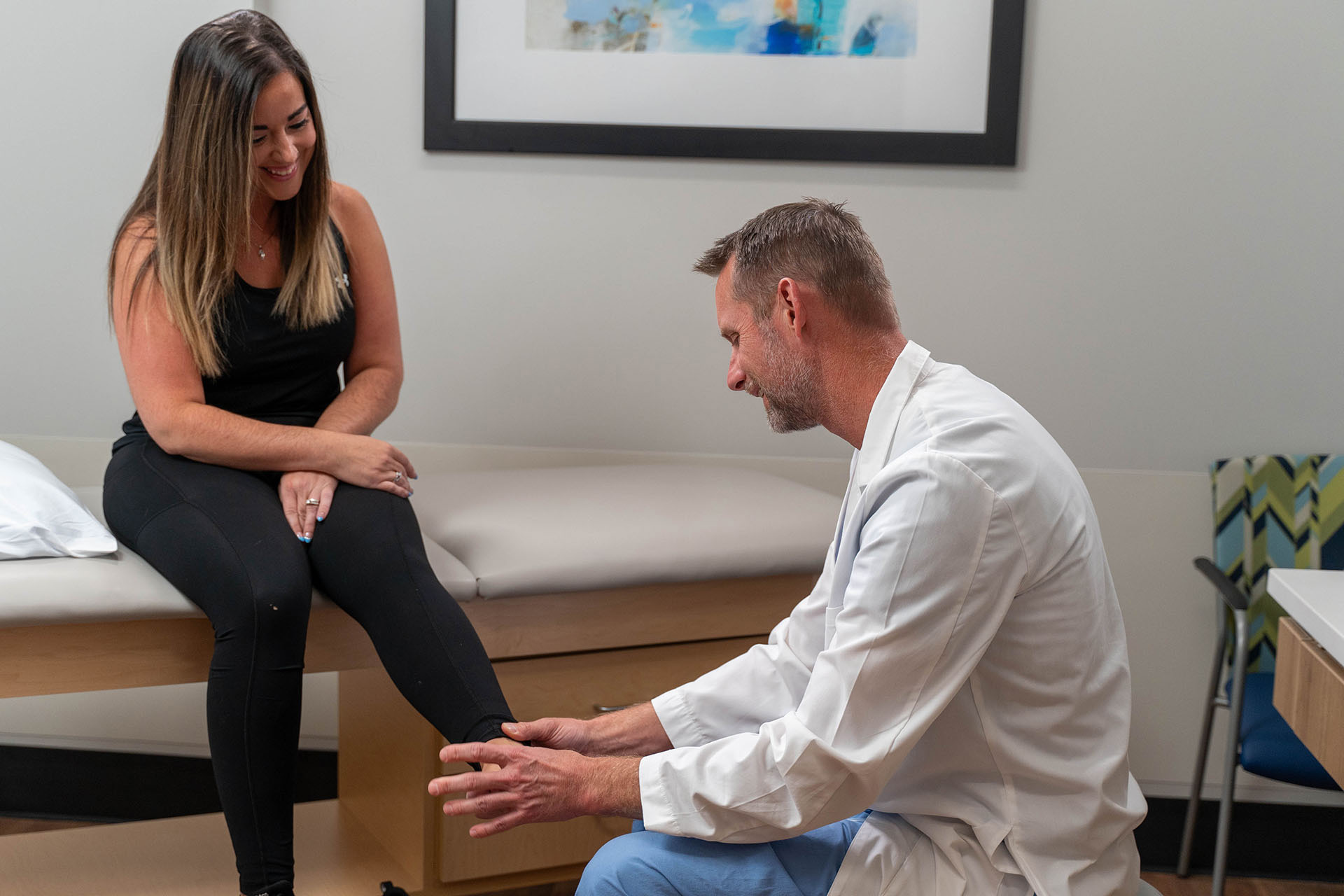Are you suffering from a potential Diabetic Foot?
The Omaha Foot & Ankle Specialists at MD West ONE are able to properly diagnose and treat diabetic foot through both surgical and non-surgical treatments. If you have the following symptoms, you may want to make an appointment with one of our Board Certified Specialists.
- Darkened skin on the affected area
- Diminished ability to sense hot or cold
- Numbness
- Pain
- Tingling
If diabetes-related neuropathy leads to foot ulcers, symptoms to watch out for include:
- Any changes to the skin or toenails, including cuts, blisters, calluses or sores
- Discharge of fluid or pus
- Foul smell
- Pain
- Redness
- Skin discoloration
- Swelling

Meet MD West ONE's foot and ankle specialists and learn more about how they treat diabetic foot.

Kathleen A. Grier, M.D.
Foot & Ankle Specialist

Scott T. McMullen, M.D.
Foot & Ankle Specialist

David J. Inda, M.D.
Foot & Ankle Specialist

Shane Schutt, M.D.
Foot & Ankle Specialist
Diabetic Foot Causes, Treatments & Surgery
What is Diabetic Foot?
People with diabetes often have problems with their feet. People with diabetes may develop foot develop sores, deformities, and infections more easily.
If not treated quickly, a foot ulcer or blister on a person with diabetes can get infected. Sometimes a surgeon must amputate (remove) a toe, foot, or part of the leg to prevent the spread of infection.
The following factors put you at an increased risk for Diabetic Foot:
- Nerve damage or poor blood flow in the feet.
- Trouble managing blood glucose levels over long periods, including frequent episodes of hyperglycemia (blood sugar that is too high).
- Weight problems.
- Had diabetes for a long time.
- High blood pressure or high cholesterol.

Ways to Decrease Your Risk of Developing Diabetic Foot:
To avoid hyperglycemia and diabetes-related neuropathy, you should control blood sugar carefully.
You can also reduce the risk of diabetes-related foot problems by:
- Checking your feet every day for any changes. Do not forget to look between your toes. Ask someone for help or use a mirror if needed.
- Getting your feet checked at every visit with a healthcare provider.
- Keeping your toenails trimmed and filed. Cut them straight across to prevent ingrown toenails.
- Maintaining blood flow to the feet. For example, keep your feet elevated when you sit, and wiggle your toes often. Stay active, but choose activities that are gentler on the feet, such as walking or swimming.
- Putting cornstarch or talcum powder between the toes to prevent moisture buildup.
- Smoothing any corns of calluses.
- Wearing socks and shoes (or slippers) all day. Make sure your socks are not too tight and that your shoes fit properly. Some people with diabetes wear therapeutic shoes or shoe inserts to help prevent wounds or sores.
- Washing your feet every day in warm water, not hot. Dry them thoroughly afterward, including between the toes. Then apply lotion to the tops and bottoms of the feet, but not between the toes.
It is just as important to avoid certain things. Do not:
- Cut calluses or corns or apply chemicals.
- Smoke.
- Soak your feet.
- Walk around barefoot.
- Wear tight socks or shoes.
Diagnosis
To diagnose diabetes-related foot conditions, a healthcare provider will:
- Ask about your symptoms and how well you are controlling blood glucose.
- Examine your toes, feet, and legs.
- Touch the toes, feet, and legs with various tools to check whether you have numbness.
If a diabetes-related ulcer or blister is present, the healthcare provider will likely:
- Examine it for any signs of infection, such as redness, swelling, warmth, discoloration, or discharge.
- Order tests to take pictures deeper than the skin, such as X-ray or MRI.
- Take a sample of the skin or discharge to test for infection.
Treatment Options
Care for diabetes-related foot pain may involve a doctor who specializes in the feet, called a podiatrist. Treatment may include:
- Cleaning the wound.
- Draining any fluid or pus from the ulcer.
- Removing or cutting away dead or infected tissue (called debridement).
- Applying special bandages and ointments to absorb extra fluid, protect the wound, and help it heal.
- Prescribing a wheelchair or crutches to take weight off the affected foot (called offloading).
- Prescribing oral or IV antibiotics to control and eliminate infection.
Depending on how severe the infection is, your healthcare provider may recommend hospitalization. Sometimes amputation is necessary to prevent infection from spreading to other parts of the body.
Frequently Asked Questions
Long-term high blood sugar can cause a type of nerve damage called diabetes-related neuropathy. Diabetes-related neuropathy can occur throughout the body, but most often in the legs and feet.
The condition might make you lose feeling in your feet. If your feet are numb, you might not notice a blister, cut, or sore. You might not even feel a pebble in your sock that is cutting your foot, for example. Wounds that go unnoticed and untreated can become infected.
Diabetes can also affect blood flow to your legs and feet. People with diabetes are more likely to develop peripheral artery disease (PAD). This condition causes arteries to become narrowed or blocked. Reduced blood flow (poor circulation) can make it difficult for a diabetes-related foot ulcer or infection to heal.
If you have diabetes, tell your healthcare provider right away if you experience:
- Any changes in foot shape.
- Any changes to the skin on the feet, including a wound, redness or darkness, warmth, or a funny smell.
- Hair loss on your toes, feet, or legs.
- Loss of feeling in the toes, feet, or legs.
- Pain, tingling, burning, or cramping in the feet or legs.
- Thick, yellow toenails.
American Orthopaedic Foot & Ankle Society
All of the foot and ankle surgeons in the practice are recognized members of the American Orthopaedic Foot & Ankle Society. It is the oldest and most prestigious medical society dedicated to the foot and ankle. The mission of the society is to advance science and practice of foot and ankle surgery through education, research, and advocacy on behalf of patients and practitioners. These physicians dedicate their time and energy to improving the patient experience and their knowledge in their field. For more information visit http://www.aofas.org.
MD West ONE Foot & Ankle Specialists:
The Foot & Ankle Specialists are all Board Certified and Fellowship-Trained, meaning they’ve focused their education, training and research on orthopedic surgery of the foot and ankle.
